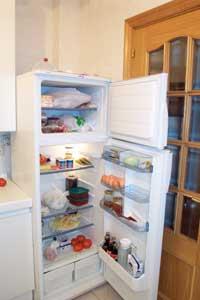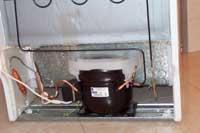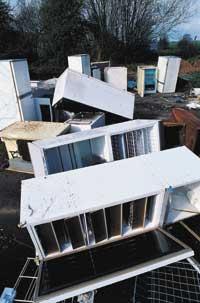Greenhouse effect in the fridge
The house refrigerator allows you to keep food for a long time without fresh or rot. Ozone and climate, however, are less influenced by refrigerators. The gases used in cold production were CFCs, but were banned in 1987 due to the destruction of the ozone layer. Instead, manufacturers began using HCF gases, but HCF have also been harmful by the subsequent warming of the planet.
Refrigerator
manufacturers were not happy when the Kyoto Protocol recognized that HCF gases generated greenhouse effect and recommended that they should be used less. HCF was introduced in the same bag along with other greenhouse gases and, although they did not prohibit their use, committed to reducing them.
Provisional solution

In
1987 the ban on universal refrigerants in refrigerators, the CFCs, fell due to the destruction of the ozone layer. Ten years later, their substitutes have been condemned by the greenhouse effect. HCF does not emit the atmosphere as much as carbon dioxide, but they have a long life. Some can withstand more than 250 years without degrading and appear to have an atmospheric heating capacity 6,500 times higher than carbon dioxide. In 1987, therefore, when the HCF replaced the CFCs, only a provisional solution was found and in a decade only one environmental problem has been replaced by another.
The
cold is consumed in modern society: the sum of industrial systems and domestic refrigerators reaches 1.2 billion units in the world and each year 60 million new units are manufactured. The cold boom occurred when buildings and vehicles began to air up in industrialized countries and the situation of industrializing countries improved slightly. But the avatars of the XIX refrigerators. They began in the 19th century, due to the loss of agricultural products on the way from producers to consumers.
The
beginnings of refrigerators are related to ammonia, sulfur dioxide and hydrocarbons. Although these gases can be flammable, toxic or both dangerous, they require a simple system. Refrigerators with ammonia cooling are currently used in industrial agriculture, for which safety measures and specific standards are available. For homes, however, refrigerators do not serve.
XX. In the early twentieth century small refrigerators were opened in the houses and the non-flammable refrigerant became essential, since the safety measures of the factories did not make sense in the kitchens of the homes. In 1930 the American engineer Midgey happily discovered the company General Motors: stable molecules derived from methane, the CFCs. The discovery spread rapidly and was used in refrigerators and was used without limits in aerosols. However, the destruction of the ozone layer was attributed to them in the early 1970s and the decline of the CFCs began.
Greenfreeze

CFCs
contain chlorine and chlorine reactions in the atmosphere destroy the ozone layer. The Montreal Protocol, signed in 1987, prohibits the production of CFCs in developed countries starting in 1995 and in developing countries starting in 2005. Household refrigerators began replacing CFCs in 1992. The manufacturers mainly used HCF as substitutes, since they do not contain chlorine are not harmful to the ozone layer. The success of these compounds was for large companies like DuPont, which are the main producers of refrigerants. The cold industry introduced large amounts of money to facilitate change. So when they were told three years ago that they had to leave the HCF, they became very angry.
There are two alternatives to replace greenhouse HCF's, either a less aggressive cooling fluid is found in the atmosphere or it is returned to pre-1930 solutions, i.e. ammonia and hydrocarbons. The debate is also intense due to the confrontation between environmentalists and producers.
The
long life of HCF for environmental associations is the main cause of their rejection. Greenpeace, for example, launched a campaign in 1997 to support alternative refrigerants, specifically hydrocarbons. The environmental organization proposed a refrigerator called greenfreeze to fight the HCF.

Greenfreez uses isobutane and propane as a refrigerant. The compounds belong to the hydrocarbon group. These chemical compounds do not destroy the ozone layer or cause greenhouse effects. But they are flammable and require stricter safety measures. However, Greenpeace believes that the risk is not as high as it is said, as the cooling system uses small volumes of compounds. Greenfrees also have higher energy efficiency and easier maintenance than conventional refrigerators. European manufacturers clung to pressure and began to use hydrocarbons, mainly German (Bosch-Siemens, Liebpaís) and Swedish (Elektrolux). In southern European countries HCF is still being used.
Greenpeace works especially in developing countries in favor of strikes. Refrigerator sales are growing 15% annually and the market is constantly expanding. China, for example, has the largest industry in the world in refrigerators. 15 years ago there were no refrigerators in the houses of the Chinese and today there are 25%. In cities the amount increases to 90%. In Indonesia and India, the refrigeration industry is growing at a similar speed.
Arguments
in favour of hydrocarbide-based refrigerators are particularly strong in these countries, where CFCs remain legal. But in 5 years they will have no choice but to leave the CFCs and then what? Change again immediately with HCF? The replacement of CFCs by hydrocarbons would imply a smaller change and would not be in the hands of Western companies producing HCF, since the hydrocarbon production technology is simpler. Of the 12 large Chinese companies, 8 have already gone to hydrocarbons and 30% of the market. On the other hand, hydrocarbon production is 80% cheaper than HCF.
Carbon dioxide

The other option is to reduce emissions while still using HCF. To do this, it is necessary to improve the insulation systems of refrigerants and to recycle the appliances that have passed a full life of use. Roads are also being investigated to create colder with less refrigerants.
On
the other hand, the miracle may come from the gas that produces the main cause of the greenhouse effect, that is, from carbon dioxide. In the last century carbon dioxide was used to heat large buildings. However, the technique was suspended because the pressure of gas use required great pressures and very strong ducts. But advances in materials make it possible to recover the space lost by carbon dioxide. This is the circle picture.
The law in favor

The
new regulations adopted by the European Union in 1994 on ozone destroying products have recently been renewed. The new regulation, which entered into force on 1 October 2000, strictly prohibits the commercialization in the European Union of any substance containing CFCs, both in refrigerators and in air conditioning systems. At the same time, the ban on dumping the eodocein apparatus containing CFCs directly to landfill has been confirmed. On the other hand, it indicates that the compounds used as insulators in refrigerators must be eliminated by 2004. In fact, these substances have the ability to destroy ozone, but not as much as CFCs.
Published in the supplement Natura de Gara
Buletina
Bidali zure helbide elektronikoa eta jaso asteroko buletina zure sarrera-ontzian











